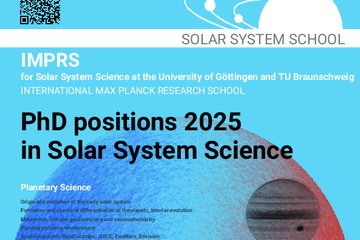All genres
141.
Journal Article
How to use magnetic field information for coronal loop identification. Solar Physics 228, pp. 67 - 78 (2005)
142.
Journal Article
Comparing magnetic field extrapolations with measurements of magnetic loops. Astronomy and Astrophysics 433, pp. 701 - 705 (2005)
143.
Journal Article
Links between magnetic fields and plasma flows in a coronal hole. Astronomy and Astrophysics 432, pp. L1 - L4 (2005)
144.
Journal Article
Coronal plasma flows and magnetic fields in solar active regions Combined observations from SOHO and NSO/Kitt Peak. Astronomy and Astrophysics 428, pp. 629 - 645 (2004)
145.
Journal Article
Optimization code with weighting function for the reconstruction of coronal magnetic fields. Solar Physics 219, pp. 87 - 108 (2004)
146.
Journal Article
Similarities and differences between coronal holes and the quiet sun: are loop statistics the key? Solar Physics 225, pp. 227 - 247 (2004)
147.
Journal Article
A quantitative method to optimise magnetic field line fitting of observed coronal loops. Solar Physics 218, pp. 29 - 40 (2003)
148.
Journal Article
Magnetic modelling and tomography: First steps towards a consistent reconstruction of the solar corona. Solar Physics 214, pp. 287 - 312 (2003)
149.
Journal Article
Computing nonlinear force free coronal magnetic fields. Nonlinear Processes in Geophysics 10, pp. 313 - 322 (2003)
150.
Journal Article
Evolution of magnetic helicity under kinetic magnetic reconnection 2. B ≠ 0 reconnection. Nonlinear Processes in Geophysics 9 (2), pp. 139 - 147 (2002)
151.
Journal Article
Including stereoscopic information in the reconstruction of coronal magnetic fields. Solar Physics 208, pp. 233 - 251 (2002)
152.
Journal Article
Evolution of magnetic helicity in the course of kinetic magnetic reconnection 1. B=0 reconnection. Nonlinear Processes in Geophysics 8 (3), pp. 127 - 140 (2001)
153.
Journal Article
Kinetic simultations of the coupling between current instabilities and reconnection in thin current sheets. Nonlinear Processes in Geophysics 7, pp. 141 - 150 (2000)
154.
Journal Article
Helmet Streamers with Triple Structures: Simulations of resistive dynamics. Solar Physics 191 (2), pp. 391 - 407 (2000)
155.
Journal Article
Solar magnetic fields: Triple arcade structures. Physica Scripta T74, pp. 77 - 81 (1998)
156.
Book Chapter
Particle code simulation - Tests and limits of Vlasov code simulations and its application to null-helicity and co-helicity reconnection. In: Space Plasma Simulation, pp. 58 - 61 (Eds. Büchner, J.; Dum, C.; Scholer, M.). Copernicus Gesellschaft 2001 (2001)
157.
Conference Paper
Computing the global coronal magnetic field during activity maximum and minimum with a newly developed nonlinear force-free Yin-Yang code. In: EGU General Assembly Conference Abstracts, pp. EGU - 17168. EGU General Assembly Conference Abstracts, Vienna, Austria, 2023. (2023)
158.
Conference Paper
Internetwork Horizontal Magnetic Fields in the Quiet Sun Chromoshpere: Results from a Joint Hinode/VTT Study. In: The Second Hinode Science Meeting: Beyond Discovery - Torward Understanding, 327 (Eds. B., L.; M., C.; T., M.; J., M.; K., R.). (2009)
159.
Conference Paper
Hanle Effect Diagnostics of the Coronal Magnetic Field: A Test Using Realistic Magnetic Field Configurations. In: Solar Polarization 5: In Honor of Jan Stenflo, pp. 429 - 434 (Eds. Berdyugina, S. V.; Nagendra, K. N.; Ramelli, R.). (2009)
160.
Conference Paper
Loop morphology and flows and their relation to the magnetic field. In: First Results from Hinode, p. 196 (Eds. Matthews, S.; Davis, J. M.; Harra, L. K.). (2008)











